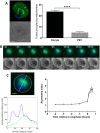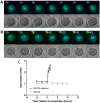Biased inheritance of mitochondria during asymmetric cell division in the mouse oocyte
- PMID: 23659999
- PMCID: PMC3699109
- DOI: 10.1242/jcs.128744
Biased inheritance of mitochondria during asymmetric cell division in the mouse oocyte
Abstract
A fundamental rule of cell division is that daughter cells inherit half the DNA complement and an appropriate proportion of cellular organelles. The highly asymmetric cell divisions of female meiosis present a different challenge because one of the daughters, the polar body, is destined to degenerate, putting at risk essential maternally inherited organelles such as mitochondria. We have therefore investigated mitochondrial inheritance during the meiotic divisions of the mouse oocyte. We find that mitochondria are aggregated around the spindle by a dynein-mediated mechanism during meiosis I, and migrate together with the spindle towards the oocyte cortex. However, at cell division they are not equally segregated and move instead towards the oocyte-directed spindle pole and are excluded from the polar body. We show that this asymmetrical inheritance in favour of the oocyte is not caused by bias in the spindle itself but is dependent on an intact actin cytoskeleton, spindle-cortex proximity, and cell cycle progression. Thus, oocyte-biased inheritance of mitochondria is a variation on rules that normally govern organelle segregation at cell division, and ensures that essential maternally inherited mitochondria are retained to provide ATP for early mammalian development.
Keywords: Asymmetry; Mitochondria; Oocyte.
Figures







Similar articles
-
Actin filaments: key players in the control of asymmetric divisions in mouse oocytes.Biol Cell. 2009 Feb;101(2):69-76. doi: 10.1042/BC20080003. Biol Cell. 2009. PMID: 19076067 Review.
-
RAB35 depletion affects spindle formation and actin-based spindle migration in mouse oocyte meiosis.Mol Hum Reprod. 2019 Jul 1;25(7):359-372. doi: 10.1093/molehr/gaz027. Mol Hum Reprod. 2019. PMID: 31152166
-
FHOD1 regulates cytoplasmic actin-based spindle migration for mouse oocyte asymmetric cell division.J Cell Physiol. 2018 Mar;233(3):2270-2278. doi: 10.1002/jcp.26099. Epub 2017 Aug 17. J Cell Physiol. 2018. PMID: 28708292
-
Actin cytoskeleton in cell polarity and asymmetric division during mouse oocyte maturation.Cytoskeleton (Hoboken). 2012 Oct;69(10):727-37. doi: 10.1002/cm.21048. Epub 2012 Aug 13. Cytoskeleton (Hoboken). 2012. PMID: 22753278 Review.
-
WDR62 is a novel participator in spindle migration and asymmetric cytokinesis during mouse oocyte meiotic maturation.Exp Cell Res. 2020 Feb 1;387(1):111773. doi: 10.1016/j.yexcr.2019.111773. Epub 2019 Dec 10. Exp Cell Res. 2020. PMID: 31836472
Cited by
-
Nampt-mediated spindle sizing secures a post-anaphase increase in spindle speed required for extreme asymmetry.Nat Commun. 2020 Jul 7;11(1):3393. doi: 10.1038/s41467-020-17088-6. Nat Commun. 2020. PMID: 32636388 Free PMC article.
-
Dynamic organelle distribution initiates actin-based spindle migration in mouse oocytes.Nat Commun. 2020 Jan 14;11(1):277. doi: 10.1038/s41467-019-14068-3. Nat Commun. 2020. PMID: 31937754 Free PMC article.
-
A guiding torch at the poles: the multiple roles of spindle microtubule-organizing centers during cell division.Cell Cycle. 2020 Jun;19(12):1405-1421. doi: 10.1080/15384101.2020.1754586. Epub 2020 May 13. Cell Cycle. 2020. PMID: 32401610 Free PMC article. Review.
-
Normalized polarization ratios for the analysis of cell polarity.PLoS One. 2014 Jun 25;9(6):e99885. doi: 10.1371/journal.pone.0099885. eCollection 2014. PLoS One. 2014. PMID: 24963926 Free PMC article.
-
Kinesin KIF3A regulates meiotic progression and spindle assembly in oocyte meiosis.Cell Mol Life Sci. 2024 Apr 8;81(1):168. doi: 10.1007/s00018-024-05213-3. Cell Mol Life Sci. 2024. PMID: 38587639 Free PMC article.
References
Publication types
MeSH terms
Grants and funding
LinkOut - more resources
Full Text Sources
Other Literature Sources

